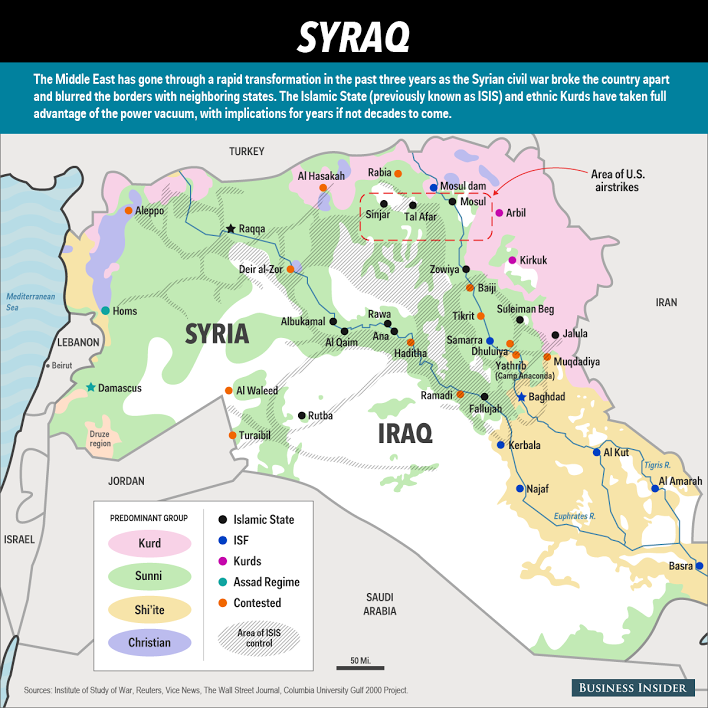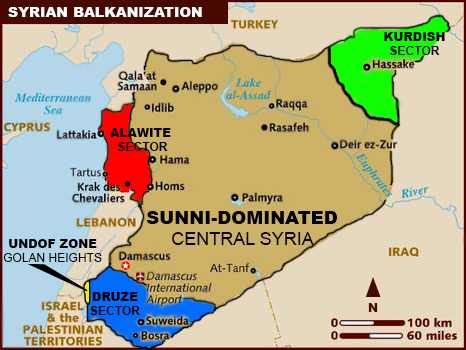 Four years into a war that has killed more than 220,000 people, Syrian President Bashar al-Assad can no longer defend the whole country or hope to regain lost territory and his forces are retreating and fortifying their core strongholds, from the capital Damascus up to the coastal strip in north-western Syria.
Four years into a war that has killed more than 220,000 people, Syrian President Bashar al-Assad can no longer defend the whole country or hope to regain lost territory and his forces are retreating and fortifying their core strongholds, from the capital Damascus up to the coastal strip in north-western Syria.
At the same time, the main blocs of insurgents, Islamic State in the east, a rival Islamist alliance in the northwest, nationalist rebels in the south and Kurds in the north are carving out their own fiefdoms in what looks like the de facto partition of Syria.
While few things are certain in the chaos of Syria’s civil war, few experts who study the conflict are in any doubt that the blood-spattered pieces of the puzzle are rearranging themselves into a new pattern – of arenas ruled by warlords.
“Syria is in the stage of undeclared partition,” said Rami Abdulrahman, head of the Syrian Observatory for Human Rights, whose networks have provided usually accurate reports on areas to which foreign officials and journalists have little access.
“The regime is trying to minimize its deployment on many frontlines to focus its forces in limited areas of strategic importance,” London-based Abdulrahman told Reuters.
He said authorities are trying to fortify the coastal area by setting up a Coastal Shield Brigade, whose mission is to defend villages which are predominantly Alawite, the minority sect, an offshoot of Shi’ite Islam, to which Assad belongs.
“They are enrolling volunteers now. Syrian officers from the (elite) Republican Guard are conducting the training with Iranian officers and (Lebanese militant movement) Hezbollah.”
DE FACTO PARTITION
Since March, Assad has steadily lost more territory and his shrunken army and militia, reinforced over the past months by Iranian forces and Shi’ite allies like the Lebanese Hezbollah paramilitaries, are withdrawing to more defensible lines.
The first sign the war was changing shape came with the fall of Idlib city in the northwest in March, followed by Jisr al-Shughour, a strategic town that opens the road to Latakia and the coast, heartland of the Assad family’s Alawite sect.
These two victories were won by Jaish al-Fatah, or Army of Conquest, the recently formed coalition between the Nusra Front the al Qaeda affiliate in Syria, and Ahrar al-Sham, a Salafist militia, and other groups using an arsenal including modern anti-tank weapons diplomats say arrived through Turkey.
Operating from a new command and control center in Idlib, Jaish al-Fatah is now pressing toward the Assad-held western side of the northern city of Aleppo – Syria’s famous trading capital, much of it razed by government artillery and bombing.
Islamic State, meanwhile, which declared its caliphate in Syria and Iraq a year ago, has pushed out of its stronghold of Raqqa, which neither the Syrian air force or the U.S.-led coalition carrying out air strikes against the Sunni jihadis in both countries seemed able to stop.
IS captured the Syrian stronghold from which it surged into Iraq last June from other groups, but last month it took Palmyra in central Syria, known for its Roman-era ruins, as Assad forces pulled back westwards.
In the south, after a failed offensive led by Iran’s Revolutionary Guards and Hezbollah to root out insurgents threatening the road to Damascus, the city of Deraa, where the revolt against Assad’s rule began in 2011, may be about to fall to the Southern Front, mainstream rebels run by operations rooms over the border in Jordan staffed by U.S. and Western officials.
In the northeast, Syrian Kurdish fighters have managed to link up a long swathe of land seized from IS near the Turkish border, first at Kobani and then, this month, at Tel Abyad, cutting supply lines from Turkey down to its capital at Raqqa.
OLD SYRIA NO LONGER
Fawaz Gerges, professor of international relations at the London School of Economics, says “The old Syria, the nation state, the state itself, is no longer; what we have now is warring, rival … tribes, non-state actors, warlords.”
“It will be extremely difficult to glue Syria back together as one country, the social fabric, the thick ties that bind it together have been dismantled,” says Gerges, an expert on Syria.
“Assad rule is really an area that corresponds more or less with a core identity area, yes there are many Sunnis and Christians living there but they see themselves as part of this core – the middle-class, upper-class Sunnis and Christians.”
The Assad government is only now, under pressure from its main allies, Iran and Russia, coming to terms with its basic weakness: It is a minority rule which has a growing shortage of manpower fighting Sunni Jihadis and rebels in Sunni areas.
Abdulrahman says “The defeat in Idlib was a shock to the regime because one of their commanders practically didn’t fight (and) at Palmyra the regime didn’t have the ability to defend it because it cannot replace each and every soldier it is losing.” The government lost 300 troops in Palmyra, he says.
The Syrian government and Hezbollah say the recent setbacks are part of the normal ebb and flow of a conflict where they have lost and regained territory in the past.
Assad’s air force still gives the military an important edge over its enemies. After losing Idlib, the army appears to be fighting hard to maintain its foothold in cities including Deraa – the focus of a new rebel offensive – and Hasaka, where Islamic State has launched an attack on government forces.
From mid-May, thousands of Iranian-organised reinforcements have arrived in the coastal northwest and around Damascus, Abdulrahman and diplomats who follow Syria say.
“It is over,” Abdulrahman says. “From now on the minority will not rule the majority. Bashar is not convinced but the Alawites, who sustained (proportionally) the biggest losses in Syria, are. More than 80,000 Alawites from the army and militias have been killed according to registered (death) certificates but the real figures are estimated at 120,000 dead.”
A LONG WAR?
Sarkis Naoum, a leading commentator, said there was a conviction among Russia, Iran and Hezbollah that Assad has lost the war or the prospect of regaining control of all of Syria.
“We will see under the plan B what he will retain,” he told Reuters. “It might be impossible for him in the long term to retain Damascus, Aleppo or Hama. He will have the coastal area including Homs.”
However much Syria fragments, its ultimate fate could depend on the regional contest between Shi’ite Iran and Sunni Saudi Arabia, analysts say, meaning the war could go on for years.
For now, the most hardline strain of Sunni jihadism, Islamic State, controls eastern Syria and much of western Iraq, and incites its followers to commit attacks such as last Friday’s attacks in France, Kuwait and Tunisia.
At the same time, Shi’ite Iran is trying to consolidate another stronghold on the Syrian Mediterranean alongside its Hezbollah bastion in Lebanon.
Yet, warns Abdulrahman, the new frontlines in Syria remain every bit as menacing, with minorities in particular at the mercy of jihadi militants.
“Even if the regime collapses tomorrow there won’t be a solution in Syria before 10 years. There are tens of thousands of Alawite fighters who will find it impossible to hand over their weapons because they will be massacred. Who will get rid of the more than 50,000 jihadis who entered Syria?”
REUTERS

Leave a Reply
You must be logged in to post a comment.